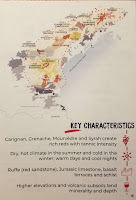Alentejo is a Portuguese wine region that I vow one day to visit. It covers much of Portugal’s southern half, spanning the flatlands below the Tejo River down to Portugal's southern Atlantic Coast. It accounts for 13% of Portugal's area under vine and 18% of wine production. Alentejo incorporates eight sub-viticultural zones (from north to south: Portalegre, Borba, Évora, Redondo, Reguengos, Granja-Amareleja, Vidigueira, & Moura). The climate is hot and dry with both a Continental and Mediterranean climate with winters exceptionally cold whereas spring and summer are dry and hot. The region experiences high levels of sunshine in the growing season -- over 3,000 hours annually. Wine-searcher.com also shares that the "Alentejo is broadly flat with hilly areas dotted across its zone. Major mountainous or hilly regions across the area include the Serra de São Mamede (1025m) on the border with Spain at the very northeastern end of the area, and the Serra de Portel (421m) and the Serra d’Ossa (649m), both in the central east".The Herdade do Esporão estate is located in the Reguengos de Monsaraz DOC sub-region which itself is located squarely in central Alentejo. The granite and schist soils and the local climate are particularly favorable to vine-growing and the region is well known for its production of high-quality wines with their own distinctive characteristics (VisitPortugal). The region provides the estate with two key advantages: access to water and diversity of soils. According to the winery, "Alentejo is a dry region, averaging just 58 cm/23 inches of rainfall per year. The estate sits on a probable north–south fault zone; fault zones coincide with areas blessed with groundwater. This relative abundance of water was decisive to the medieval occupation of the land and building of the defensive Esporão tower.Soil mapping begun in 2008 by geologist José Borrego established that at least seven different soils exist within the property, with dioritic soils (medium- to coarse-grained igneous rock) found only at the estate. Dioritic soils result in wines wines with lots of aroma, fruit, and acidity. Granite-origin granodiorite soils eventually yield wines with great freshness and minerality. Other soils include mottled schists (the Reserva Red) for grapes with high sugar and phenol levels, and two different versions of sandy clay loam soils are home to some of the white grapes".
The boundaries of the Herdade do Esporão estate were first established in 1267 and have been unaltered since. In 1973, José Roquette and Joaquim Bandeira bought the property because the Reguengos sub-region "ensures wines that were full-bodied but elegant and both big and seductive, thanks to a mix of very poor, stony soils and a harsh climate". The first wine was produced in 1985 using the brand name Esporão which coincidently was the Esporão Reserva Red -- which we will be reviewing the 26th vintage. Currently, they have 450 hectares of vines planted with 194 grape varieties, 37 of which are in full production. Four of these grapes are included in the newly debuted Esporão Monte Velho Reserva Red 2022 ($18).
Traditionally, the winery's Monte Velho Red, White, and Rosé line is aged in stainless steel, but the Reserva is treated with eight months in oak. The wine is composed of Touriga Nacional, Aragonez (Tempranillo), Syrah, and Trincadeira with an average vine age of 18 years. and the grapes were grown on barren granitic schist eroded into clay-like fragments. The granite schist provides structure to the wines, while its clayey texture helps with water retention. The Touriga Nacional offers dark fruit and tannins; the Aragonez, red fruit with earthy, leathery notes; the Syrah floral aromas and red fruit; and the Trincadeira, fruity and floral character. I found this to be a very food friendly wine offering sour cherry and plum flavors in a creamy texture, light tobacco - a solid backbone - and lasting acidity.
















































